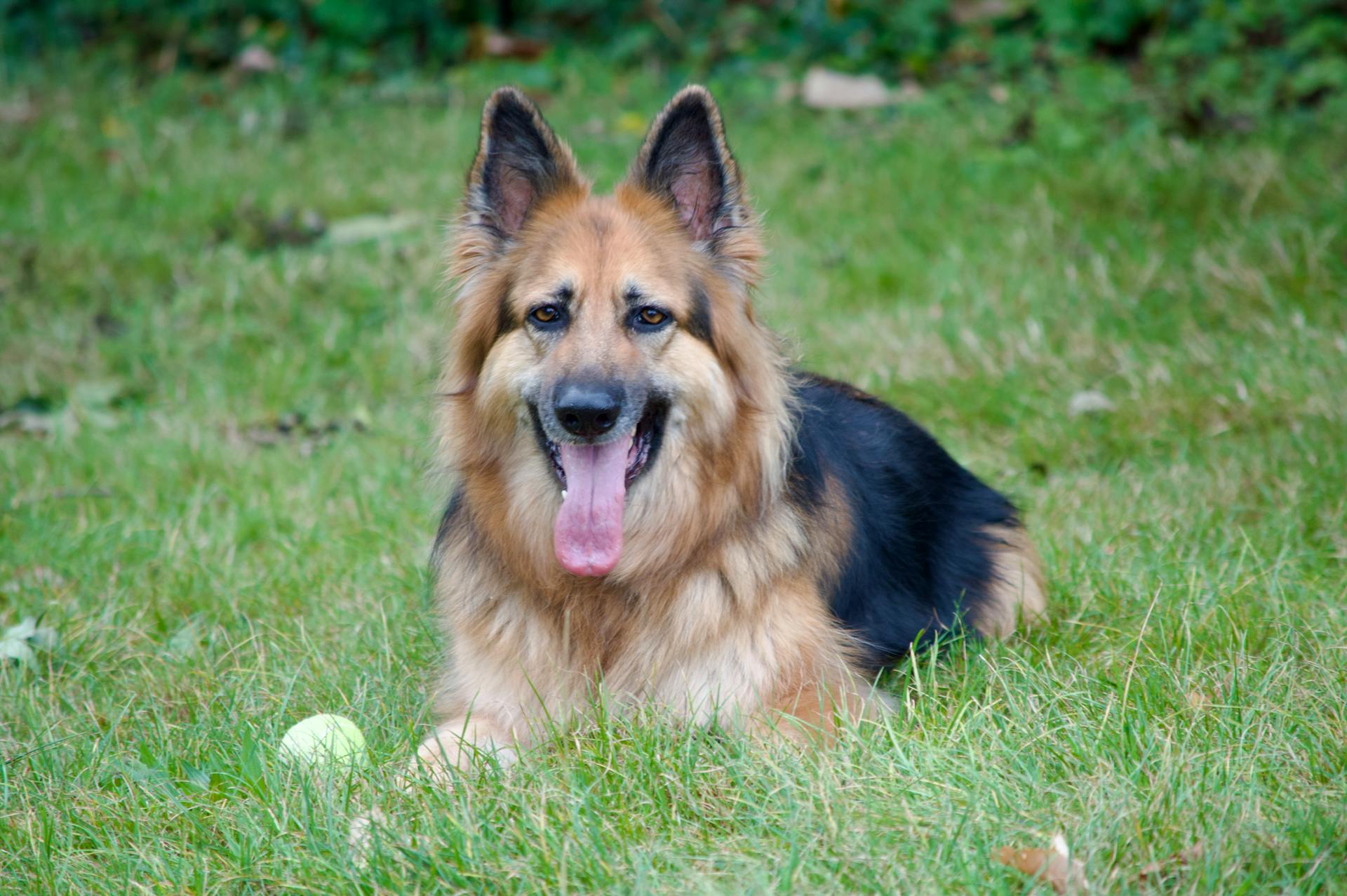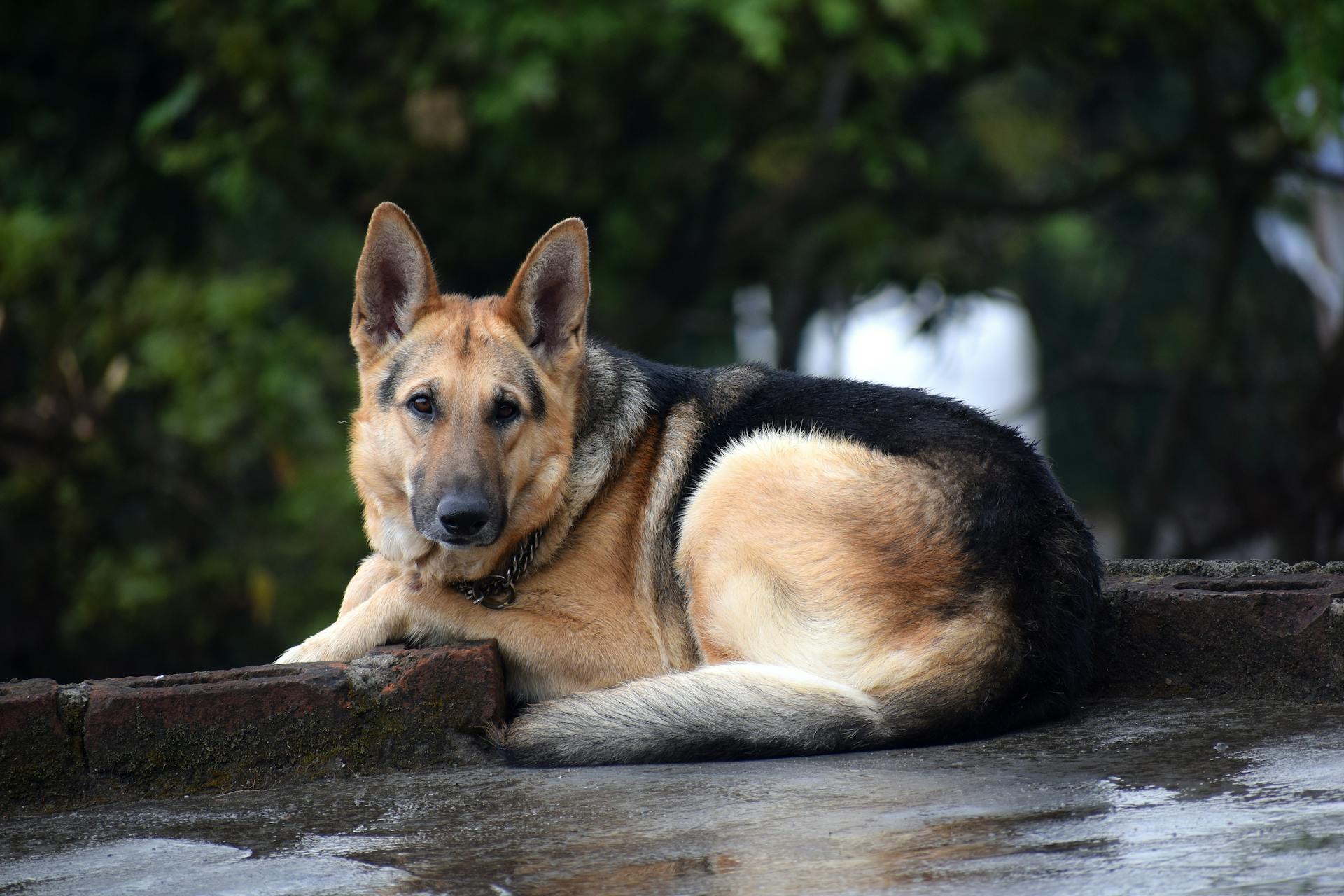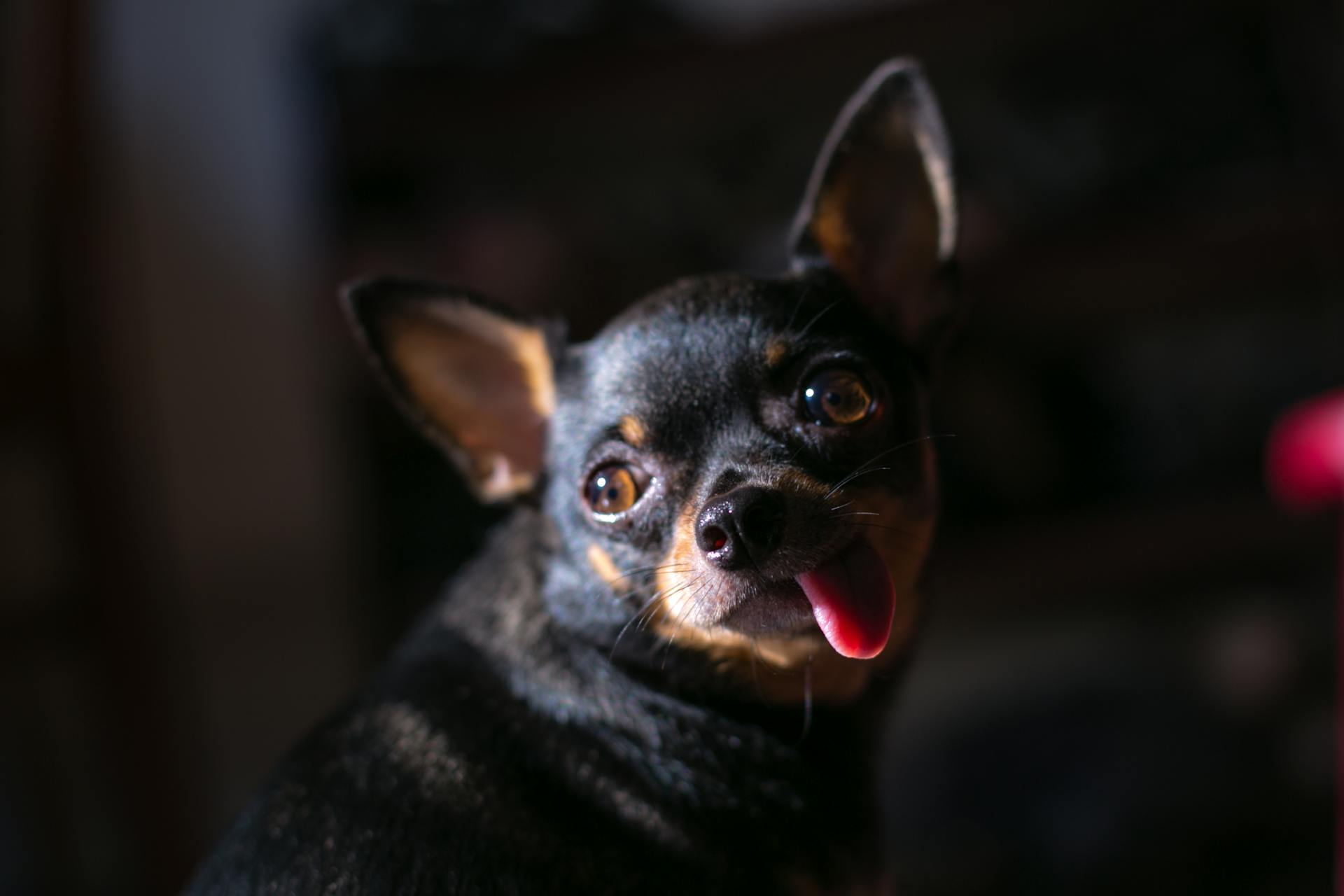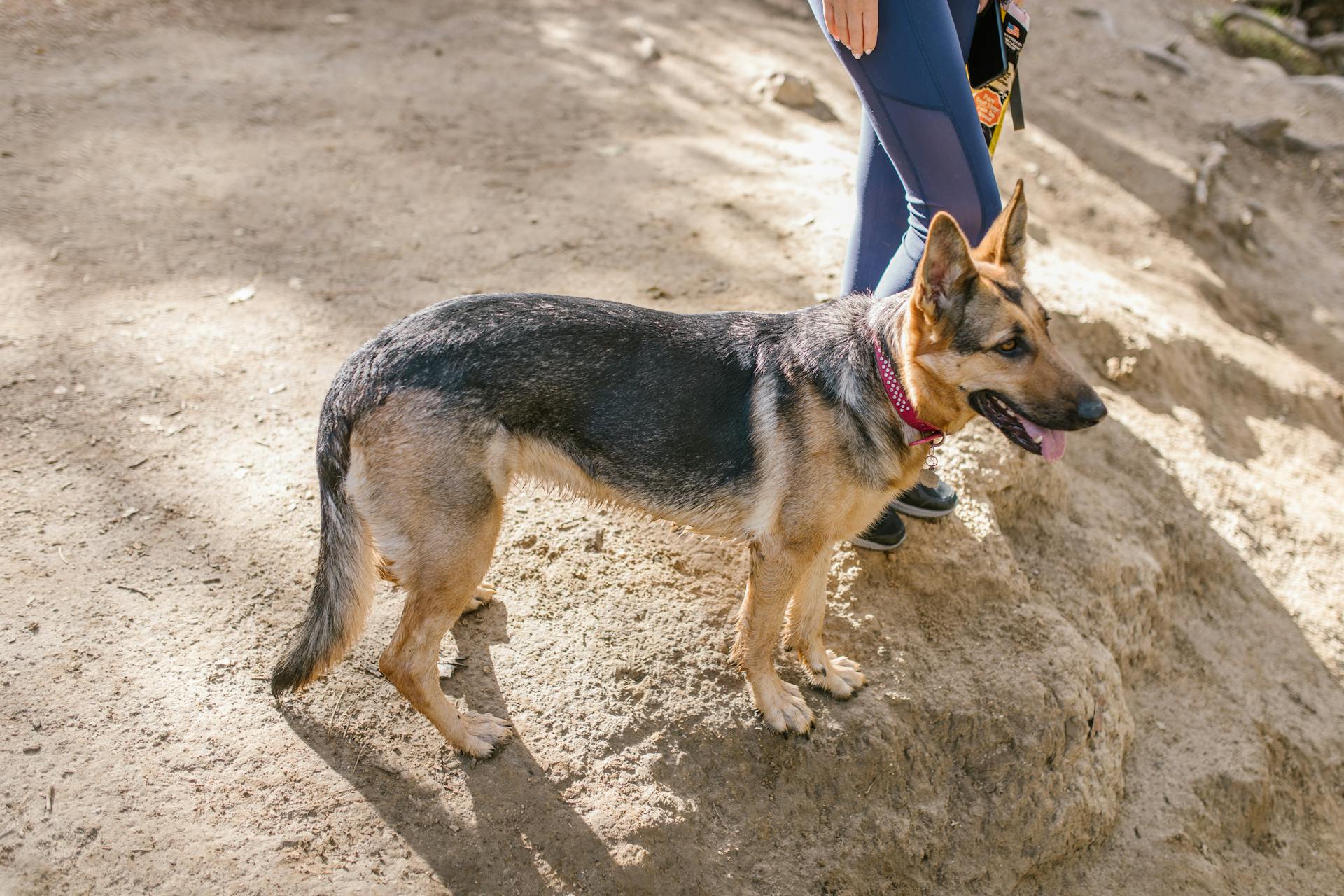
German Shepherds are one of the most popular breeds in the world, but they can also be prone to anger issues. This is often due to a lack of socialization and training, which can lead to fear-based aggression.
A German Shepherd's temperament is shaped by its genetics and environment. If a German Shepherd is not properly socialized, it may become fearful and aggressive towards strangers.
Fear-based aggression can be triggered by a variety of things, including loud noises, new people, and even new dogs. This type of aggression is often a result of the dog feeling threatened or scared.
Proper training and socialization can go a long way in preventing anger issues in German Shepherds. This includes early exposure to new people, places, and experiences, as well as positive reinforcement training methods.
Curious to learn more? Check out: How Often Do German Shepherds Need a Bath
Causes of Aggression
Aggression in German Shepherds can be a complex issue, but some common signs include barking, snarling, and charging at other dogs on walks.
Hiding behind their owner's legs when another dog is around is a clear indication that your German Shepherd is trying to protect themselves or keep their owner between them and the other dog.
Refusing to go near other dogs when out walking or in the home is another sign that your German Shepherd may be experiencing aggression.
Hiding behind furniture or in dark areas of your home if they see another animal outside being walked is a sign that your German Shepherd is overwhelmed and trying to hide from the situation.
Some medical conditions can also cause aggression in German Shepherds, so it's essential to take them to the vet for an examination to rule out any underlying health issues.
Here's an interesting read: When Do German Shepherds Blow Their Coat
Identifying and Preventing Attacks
If you find yourself in a situation where a German Shepherd is about to attack you, it's essential to remain calm and try to diffuse the situation. Avoid making direct eye contact with the dog, as this can be perceived as a challenge.
If possible, stand still and avoid abrupt movements, as this can escalate the situation. You should also call for help if needed. Remember, staying calm is key.
German Shepherds may become aggressive when they feel their territory or possessions are threatened, so it's crucial to understand their guardian instincts. This can help you prevent attacks by being aware of potential triggers.
Protecting Territory/Possessions
German Shepherds have strong guardian instincts, which may become aggressive when they feel their territory or possessions are threatened. If your GSD senses danger, he may become aggressive in an attempt to protect himself or his property.
This protective behavior can be triggered by various stimuli, but it's essential to recognize the signs of territorial or possessive behavior in your German Shepherd. Raised hackles, bared teeth, and a tense body posture are all warning signs that your dog may be feeling threatened.
In some cases, German Shepherds may even attack their owners if they perceive them as a threat to their territory or possessions. This can be especially true if your dog is not properly socialized or trained.
To prevent attacks related to territorial or possessive behavior, it's crucial to establish clear boundaries and rules in your home. By doing so, you can help your German Shepherd understand what is and isn't acceptable behavior.
A fresh viewpoint: Are German Shepherds Territorial
Preventive Measures Before a Dog Attacks
Recognizing the warning signs of an impending attack is crucial to preventing a German Shepherd from attacking. One of the most telling signs is when the dog stops listening to commands or exhibits submissive behavior like cowering and whimpering.
If you notice your German Shepherd displaying raised hackles, bared teeth, a tense body posture, snarling sounds, or direct eye contact, it's a warning sign that an attack is imminent.
Remaining calm and trying to diffuse the situation can help de-escalate the tension. Avoid making direct eye contact with the dog, as this can be perceived as a challenge.
If possible, stand still and avoid abrupt movements, as sudden actions can trigger the dog's aggressive instincts. Calling for help if needed is also a good idea.
Here are some common signs that a German Shepherd may be about to attack:
- Lunging or biting
- Stopping to listen to commands
- Exhibiting submissive behavior like cowering and whimpering
- Raised hackles
- Bared teeth
- Tense body posture
- Snarling sounds
- Direct eye contact
Quiet Voice Required
When interacting with an aggressive dog, it's essential to keep your voice down. Screaming or yelling will only make the situation worse.

In fact, trying to remain as calm and peaceful as possible is crucial in preventing an attack. This mindset is key to de-escalating the situation.
Screaming or yelling at an aggressive German Shepherd, for instance, can lead to a bite. So, it's best to avoid loud noises altogether.
By speaking in a quiet voice, you can help to calm the dog down and slowly move away from it.
You might like: When Do German Shepherds Calm down
Defending Against an Attack
If a German Shepherd attacks you, don't try to outrun it - this can make the dog more aggressive. Remain calm and try not to move suddenly.
You can fight back against an attacking dog, and in most cases, you won't hurt the dog, but the dog will hurt you. In some cases, the wounds inflicted on you by a German Shepherd can be deadly, so don't hesitate and fight back.
To defend yourself, curl up in a ball on your side and protect your neck and head with your arms, while yelling for help.
Take a look at this: Straight Backed German Shepherds
Defending Against Perceived Threats

German Shepherds may bite if they feel threatened or scared, so it's essential to recognize signs of fear and stress in your dog.
If you're angry or raise your voice at your German Shepherd, it may misinterpret this as a sign of aggression and bite out of fear.
Remaining calm is crucial when dealing with an aggressive German Shepherd, as sudden movements can provoke them further.
Try to use a small object like an umbrella or stick as a shield between you and the dog to keep it at bay.
Standing still and avoiding abrupt movements can help prevent startling or agitating the dog further, which may lead to a bite.
If the German Shepherd continues to approach you, slowly back away until you are out of reach.
German Shepherds have strong guardian instincts, which may become aggressive when they feel their territory or possessions are threatened.
In situations where the dog doesn't back away and tries to attack you, don't hesitate to fight back, as the wounds inflicted on you can be deadly.
Explore further: German Sheperd Bite Force
Calm and Diffuse Situation
Staying calm is key when faced with an aggressive German Shepherd. Remain calm and try to diffuse the situation.
Avoid making direct eye contact with the dog, as this can be perceived as a challenge. It's also essential to avoid sudden movements, as this can further provoke the dog.
If possible, stand still and avoid abrupt movements, as this can help to de-escalate the situation. This is crucial when trying to pass by an aggressive German Shepherd without being attacked.
Staying calm can help to prevent the situation from escalating. It's also essential to avoid showing fear, as dogs can sense fear and respond aggressively.
Broaden your view: When Do German Shepherds Shed the Most
Stand Still, Avoid Abrupt Movements
If you find yourself in the presence of an aggressive German Shepherd, it's essential to remain calm and composed. Remaining calm and trying to diffuse the situation is crucial, as it can help prevent the situation from escalating further.
If possible, stand still and avoid abrupt movements, as this can help prevent startling or agitating the dog further, which may lead to a bite. Slowly back away until you are out of reach, moving slowly and cautiously to avoid startling the German Shepherd.
Avoid making direct eye contact with the dog, as this can be perceived as a challenge or threat. Instead, try to defuse the situation by speaking softly or making quiet shushing noises.
Here are some key tips to keep in mind:
- Move slowly and cautiously to avoid startling the German Shepherd
- Stand still and avoid abrupt movements
- Slowly back away until you are out of reach
By following these tips, you can help prevent the situation from escalating further and reduce the risk of being bitten or attacked.
Actions After an Attack
If you've been attacked by a German Shepherd, the first thing to do is seek medical attention if needed. If you're okay, no medical intervention is required.
You should report the incident to the police or animal control authorities. They might have protocols for arranging medical treatment and possibly putting the dog in quarantine.
Filing a lawsuit against the owner of the German Shepherd is an option, but you should consult a qualified lawyer to know more about this option.
Find out if the dog has been vaccinated for rabies. If it hasn't, you may need to get treatment for rabies as soon as possible since untreated rabies can be deadly.
Getting as much information as you can about the dog's health history is crucial.
Statistics and Frequency
German Shepherd attacks are relatively uncommon, but they do happen. According to the American Veterinary Medical Association, about 4.5 million dog bites occur annually in the United States.
The German Shepherd is the fifth most dangerous breed, responsible for around 4.6% of these incidents. This percentage is higher than other larger breeds, such as Golden Retrievers and Labradors.
Pitbulls account for more than 65.6% of dog bite incidents, which is a staggering number. In comparison, German Shepherds account for only 4.6%.
Here's a breakdown of the top dog breeds responsible for attacks and fatalities:
Between 2005 and 2017, around 20 people died from the consequences of German Shepherd bites in the United States.
How to Break Up a Fight
Breaking up a dog fight can be very difficult and dangerous, so it's essential to know the right steps.
Remain calm and do not show any fear, as dogs can sense fear and will respond aggressively if they feel threatened.
Using a loud, authoritative voice to yell commands like "no" or "stop it" can help break up the fight.
Do not reach for the dogs, as this could lead to them attacking you instead of each other.
Creating a physical barrier between the two dogs by using a broom handle or a chair can be a lifesaver in a fight.
If the fight escalates, speak to your vet – they may be able to recommend an animal behaviorist who can help break up the fight and assess why it started in the first place.
After the fight is broken up, ensure both dogs are separated, not injured, and given time to calm down before attempting to re-introduce them.
Understanding German Shepherds
German Shepherds are highly intelligent and sensitive dogs, and understanding their nature is key to preventing angry outbursts. Their protective instincts can sometimes get the best of them.
Fear and anxiety can cause German Shepherds to lash out at their owners, especially if they feel startled or threatened. This can lead to biting behavior as they try to defend themselves.
Introducing Your GSD to Unfamiliar Dogs
Introducing your German Shepherd (GSD) to unfamiliar dogs can be a challenging task, but with patience and the right approach, it can be done successfully.
First, choose a calm, neutral environment with little to distract or stimulate your GSD. This will help your dog feel more at ease.
Start out slowly when making your introduction to your new dog's potential buddy. Keep your distance from the handler and their dog at first.
Reward your dog if they act calm, as this positive reinforcement encourages a positive association when your GSD meets new dogs.
Next, slowly approach the other dog and handler, and let them sniff and circle around each other. If your dog is shy or fearful, it may take several times to build up their confidence enough for them to be relaxed around other dogs.
Don't use tight leashes or pull the two dogs apart, as this can cause a negative reaction in your dog.
Here are some signs that your GSD may have a problem with aggression:
- Hiding behind their owner's legs if a dog comes around while out walking.
- Refusing to go near other dogs when they are out walking or in the home.
- Hiding behind furniture or in dark areas of your home if they see another animal outside being walked.
If your GSD is aggressive towards other animals, they may need some medical attention as well. Take them to the vet for an examination and to rule anything else out before trying any of these methods yourself.
To make the introduction process easier, start with a familiar, well-behaved canine. This will help your dog feel more at ease and teach you the best way to handle socialization episodes.
Remember to reward your dog with high-quality treats, such as Zesty Paws Calming Bites, whenever they display confident behavior. This will help them associate meeting new dogs with positive experiences.
Possessiveness Over Food and Toys
German Shepherds may become possessive of their food or toys, leading them to bite if anyone tries to take them away.
It's crucial to train your GSD early on to avoid possessiveness, as it can be a challenging habit to break later on.
To prevent possessiveness, it's essential to teach your German Shepherd that it's okay for other people or animals to take their food or toys if necessary.
This can be achieved through positive reinforcement training and socialization from an early age.
Can You Trust a German?
You can't trust a German Shepherd 100%, even with proper training and socialization, as their behavior can be unpredictable.
Their instinct may cause them to behave differently in certain situations, and it's up to the owner to recognize these behaviors and take steps to ensure its safety.
A case study showed that 87% of German Shepherd owners have 100% trust in their dogs, but this doesn't mean it's always justified.
No matter how well-trained a German Shepherd is, genetics can still kick in and cause unexpected behavior.
Most dogs are naturally loyal creatures, but they could still turn on you given the right circumstances, so trust should never be taken for granted.
It's not about how you raise them, as their natural instincts can't be completely controlled.
Desensitization and Training
Desensitization is a crucial step in helping your German Shepherd overcome anxiety and aggression issues. This involves gradually exposing your dog to the stimulus causing their anxiety, allowing them to become comfortable with it.
Take a look at this: Do German Shepherds Have Anxiety
Start by taking your German Shepherd on a walk in an area with no other dogs around, so they don't feel threatened. Then, carry on the same route but stop short of going past another dog's house, however far away that may be.
By repeating this process several times, your dog will become fine with being at that distance from another animal's house. You can then progress to walking past it, stopping short if they become anxious or aggressive.
Lack of Socialization
Lack of socialization can lead to a German Shepherd attacking its owner, as it may become anxious and scared around people, resulting in aggressive behavior.
Proper socialization is crucial for any dog, and German Shepherds are no exception. They need to learn how to behave properly in various situations.
Dogs that are not properly socialized may become anxious and scared around people, which can result in aggressive behavior. This anxiety can be triggered by new people, places, or situations.
Socialization helps German Shepherds learn obedience and how to behave properly. It's an important part of raising any dog, and it's essential to get it right from an early age.
Readers also liked: Are German Shepherds Anxious
The Desensitization Method
The Desensitization Method is a great way to help your German Shepherd feel more comfortable in situations that might otherwise cause anxiety or aggression. It involves gradually exposing your dog to the stimulus that causes the problem, starting with small steps.
Begin by taking your dog for a walk in an area where you know there aren't any other dogs around, so they don't feel threatened. This helps your dog feel more secure and relaxed.
Next, carry on the same route but stop short of going past another dog's house, however far away that may be. This allows your dog to become accustomed to the presence of another animal's house without feeling overwhelmed.
Wait for a couple of minutes at this point, allowing your dog to become comfortable in the area again before carrying on back home. This helps your dog learn to associate the presence of another animal's house with no negative consequences.
Do this several times until your dog is fine with being at that distance from another animal's house. Then, you can progress to walking past it while still stopping short if your dog becomes anxious or aggressive.
Frequently Asked Questions
How do you fix an aggressive German Shepherd?
To address aggression in German Shepherds, proper socialization and training are crucial, along with maintaining your dog's gut health through probiotics and a balanced lifestyle. Early intervention and a well-planned approach can help prevent aggression and strengthen your bond with your dog.
Sources
- https://gsdcolony.com/blogs/news/what-should-i-do-if-i-am-attacked-by-a-german-shepherd
- https://www.istockphoto.com/photos/angry-german-shepherd
- https://www.istockphoto.com/photos/german-shepherd-angry
- https://regisregal.com/how-to-fix-german-shepherd-aggression/
- https://spiritdogtraining.com/behavior/german-shepherds-dangerous/
Featured Images: pexels.com


